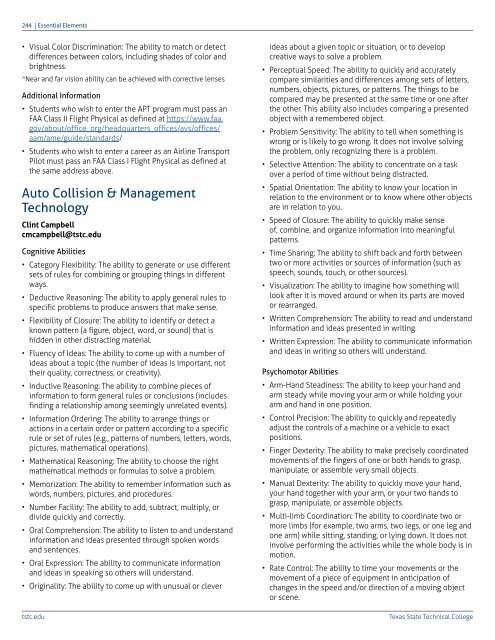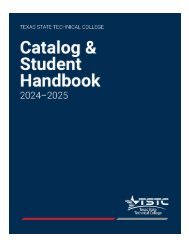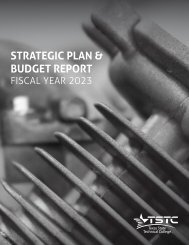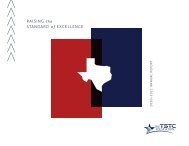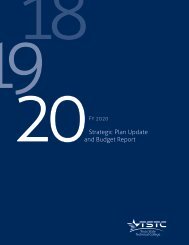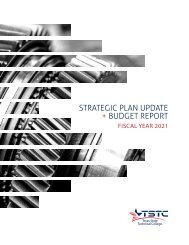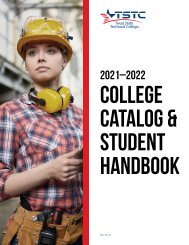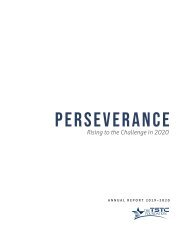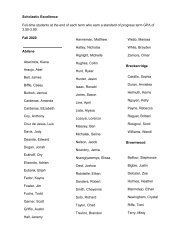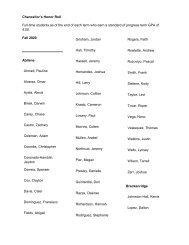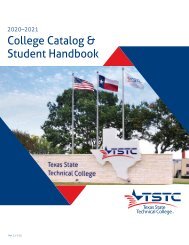Student Handbook and Catalog 2021-22 V2
You also want an ePaper? Increase the reach of your titles
YUMPU automatically turns print PDFs into web optimized ePapers that Google loves.
244 | Essential Elements<br />
• Visual Color Discrimination: The ability to match or detect<br />
differences between colors, including shades of color <strong>and</strong><br />
brightness.<br />
*Near <strong>and</strong> far vision ability can be achieved with corrective lenses<br />
Additional Information<br />
• <strong>Student</strong>s who wish to enter the APT program must pass an<br />
FAA Class II Flight Physical as defined at https://www.faa.<br />
gov/about/office_org/headquarters_offices/avs/offices/<br />
aam/ame/guide/st<strong>and</strong>ards/<br />
• <strong>Student</strong>s who wish to enter a career as an Airline Transport<br />
Pilot must pass an FAA Class I Flight Physical as defined at<br />
the same address above.<br />
Auto Collision & Management<br />
Technology<br />
Clint Campbell<br />
cmcampbell@tstc.edu<br />
Cognitive Abilities<br />
• Category Flexibility: The ability to generate or use different<br />
sets of rules for combining or grouping things in different<br />
ways.<br />
• Deductive Reasoning: The ability to apply general rules to<br />
specific problems to produce answers that make sense.<br />
• Flexibility of Closure: The ability to identify or detect a<br />
known pattern (a figure, object, word, or sound) that is<br />
hidden in other distracting material.<br />
• Fluency of Ideas: The ability to come up with a number of<br />
ideas about a topic (the number of ideas is important, not<br />
their quality, correctness, or creativity).<br />
• Inductive Reasoning: The ability to combine pieces of<br />
information to form general rules or conclusions (includes<br />
finding a relationship among seemingly unrelated events).<br />
• Information Ordering: The ability to arrange things or<br />
actions in a certain order or pattern according to a specific<br />
rule or set of rules (e.g., patterns of numbers, letters, words,<br />
pictures, mathematical operations).<br />
• Mathematical Reasoning: The ability to choose the right<br />
mathematical methods or formulas to solve a problem.<br />
• Memorization: The ability to remember information such as<br />
words, numbers, pictures, <strong>and</strong> procedures.<br />
• Number Facility: The ability to add, subtract, multiply, or<br />
divide quickly <strong>and</strong> correctly.<br />
• Oral Comprehension: The ability to listen to <strong>and</strong> underst<strong>and</strong><br />
information <strong>and</strong> ideas presented through spoken words<br />
<strong>and</strong> sentences.<br />
• Oral Expression: The ability to communicate information<br />
<strong>and</strong> ideas in speaking so others will underst<strong>and</strong>.<br />
• Originality: The ability to come up with unusual or clever<br />
tstc.edu<br />
ideas about a given topic or situation, or to develop<br />
creative ways to solve a problem.<br />
• Perceptual Speed: The ability to quickly <strong>and</strong> accurately<br />
compare similarities <strong>and</strong> differences among sets of letters,<br />
numbers, objects, pictures, or patterns. The things to be<br />
compared may be presented at the same time or one after<br />
the other. This ability also includes comparing a presented<br />
object with a remembered object.<br />
• Problem Sensitivity: The ability to tell when something is<br />
wrong or is likely to go wrong. It does not involve solving<br />
the problem, only recognizing there is a problem.<br />
• Selective Attention: The ability to concentrate on a task<br />
over a period of time without being distracted.<br />
• Spatial Orientation: The ability to know your location in<br />
relation to the environment or to know where other objects<br />
are in relation to you.<br />
• Speed of Closure: The ability to quickly make sense<br />
of, combine, <strong>and</strong> organize information into meaningful<br />
patterns.<br />
• Time Sharing: The ability to shift back <strong>and</strong> forth between<br />
two or more activities or sources of information (such as<br />
speech, sounds, touch, or other sources).<br />
• Visualization: The ability to imagine how something will<br />
look after it is moved around or when its parts are moved<br />
or rearranged.<br />
• Written Comprehension: The ability to read <strong>and</strong> underst<strong>and</strong><br />
information <strong>and</strong> ideas presented in writing.<br />
• Written Expression: The ability to communicate information<br />
<strong>and</strong> ideas in writing so others will underst<strong>and</strong>.<br />
Psychomotor Abilities<br />
• Arm-H<strong>and</strong> Steadiness: The ability to keep your h<strong>and</strong> <strong>and</strong><br />
arm steady while moving your arm or while holding your<br />
arm <strong>and</strong> h<strong>and</strong> in one position.<br />
• Control Precision: The ability to quickly <strong>and</strong> repeatedly<br />
adjust the controls of a machine or a vehicle to exact<br />
positions.<br />
• Finger Dexterity: The ability to make precisely coordinated<br />
movements of the fingers of one or both h<strong>and</strong>s to grasp,<br />
manipulate, or assemble very small objects.<br />
• Manual Dexterity: The ability to quickly move your h<strong>and</strong>,<br />
your h<strong>and</strong> together with your arm, or your two h<strong>and</strong>s to<br />
grasp, manipulate, or assemble objects.<br />
• Multi-limb Coordination: The ability to coordinate two or<br />
more limbs (for example, two arms, two legs, or one leg <strong>and</strong><br />
one arm) while sitting, st<strong>and</strong>ing, or lying down. It does not<br />
involve performing the activities while the whole body is in<br />
motion.<br />
• Rate Control: The ability to time your movements or the<br />
movement of a piece of equipment in anticipation of<br />
changes in the speed <strong>and</strong>/or direction of a moving object<br />
or scene.<br />
Texas State Technical College


